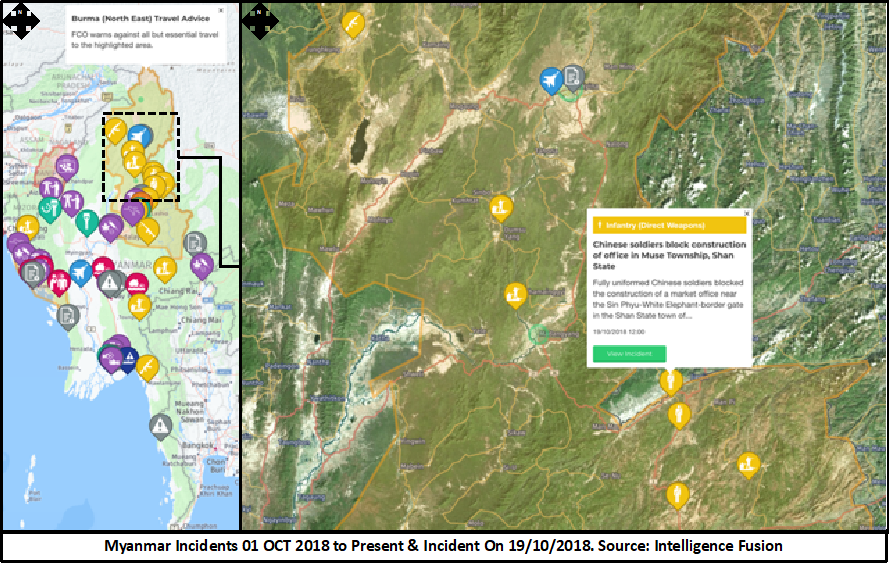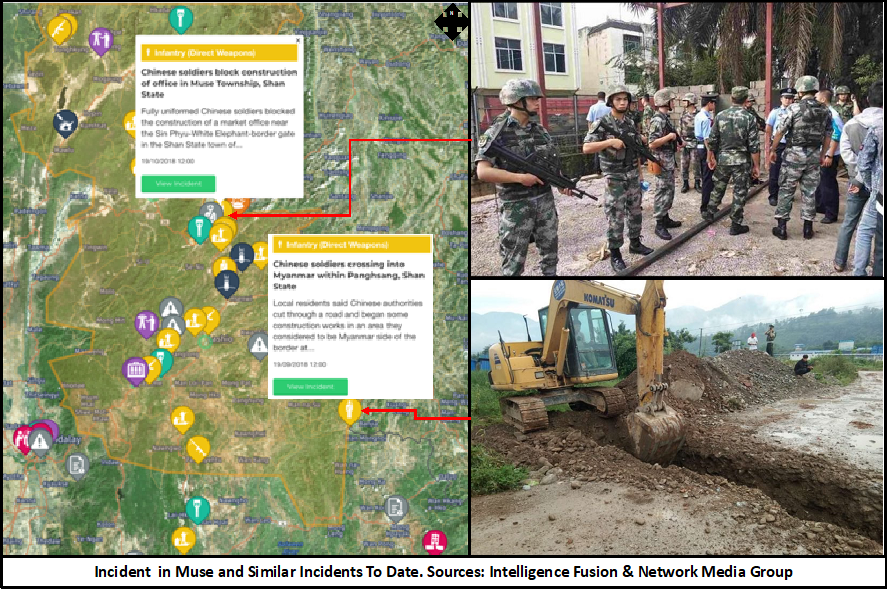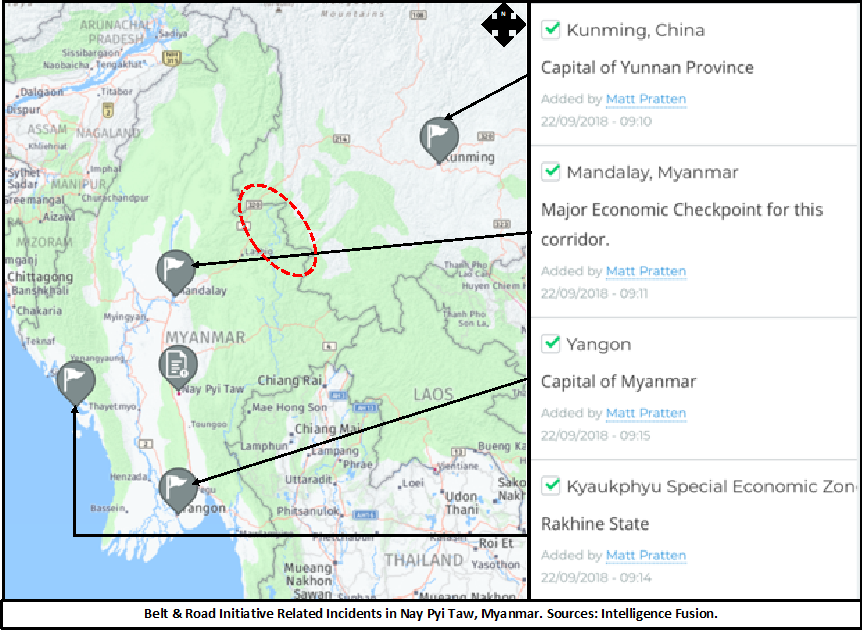Myanmar: Chinese Forces Cross into Shan State
Date of Incident: 19 October 2018
Date of Report: 29 October 2018
EXECUTIVE SUMMARY
While it is not conclusive at this stage, this recent incident in Muse Township, Shan State adds further weight to prior analysis about Chinese intentions along the border it shares with Shan State, Myanmar. It is POSSIBLE the Chinese are utilising the ongoing armed conflicts in Shan State as a cover in order to encroach into Myanmar and seize territory.
INTRODUCTION
This Intelligence Report on Myanmar is intended to analyse what has been happening within the country in terms of threats which are tracked by Intelligence Fusion; those being threats of Direct Weapons, Suicide/Complex Attacks, Indirect Weapons, Air, Maritime, Grenades, Protests, Criminality, Hazards and Other. This report aims to provide analysis in terms of the following Intelligence Requirements:
- What threats exist in Myanmar?
- How do these threats continue to exist?
- What are the issues behind these threats?
- What significant events will affect the country’s situation and threats?
Open Source reporting from the 19 OCT 2018 has indicated on the same day; the Chinese People’s Liberation Army crossed into Muse Township, Shan State, Myanmar. The purpose was to block the construction of a market office. Available reporting indicates the soldiers used an interpreter and informed local residents the land belonged to China. A local willing to speak to the media stated the soldiers came into Burma through an unofficial entrance and that Chinese reinforcement troops and tanks were stationed nearby (Network Media Group 2018; McCabe & Harrington 2018).

COMMENT. Available imagery only supports that armed soldiers were in the area. The claims of tanks being in the area cannot be supported at this time. Previous reporting indicates this is the second incident of its kind in the last 2 months. Previously, Chinese soldiers had crossed into Myanmar further south in Panghsang, Shan State. On 19 SEP 2018 at Hpai Kawng village in Panghsang / Pangsai – a town located on the border with China – local residents claimed Chinese authorities cut through a road and began some construction works on Myanmar’s side of the border. Available reporting indicates a resident confronted the Chinese soldiers about their activities; one soldier replied that they considered it to be on the Chinese side ((Pratten et al. 2018; McCabe & Harrington 2018).

Shown in the imagery below, this area of Shan State and these incidents – shown in red – sit between Myanmar’s major economic centres and Kunming, China. Previous reporting has shown that China and Myanmar have agreed on 09 SEP 2018, Myanmar has signed an MoU with China agreeing to establish the CMEC, part of China’s BRI. The aim is to construct basic infrastructure across key economic centres in Myanmar. As shown in the imagery below, the CMEC is an estimated 1,700-kilometer-long corridor that will connect Kunming in Yunnan Province, to Myanmar’s major economic checkpoints in Mandalay, Yangon and to the Kyaukphyu SEZ (Pratten et al. 2018).

When Chinese soldiers crossed into Panghsang after the CMEC MoU was signed, analysis of the incidents was there is POTENTIAL the Chinese will conduct further crossings into Myanmar from its border in order to achieve its goals for the BRI. The strategic goals for China’s BRI will POTENITALLY mean the Chinese will cross into Shan State and other areas of Northern Myanmar. This second crossing further north in Muse – similar to the crossing in Panghsang – has occurred during a time where there have been ongoing skirmishes between Myanmar’s Tatmadaw and various EAG’s. This second incident up in Muse Township would appear to add weight to prior analysis that these clashes provide POTENTIAL cover for the Chinese to encroach into Myanmar but there is also POTENTIAL for Chinese forces to come into contact with Tatmadaw forces and EAG’s, exacerbating an already violent situation within Northern Myanmar (Pratten et al. 2018). COMMENT ENDS.
ASSESSMENT
| POTENTIAL/POTENTIALLY | POSSIBLE/POSSIBLY | PROBABLE/PROBABLY | CONFIRMED |
| Less than 50% chance | 50% chance or greater | 75% chance or greater | 95% chance or greater |
While it is not conclusive at this stage, this recent incident in Muse Township, Shan State adds further weight to prior analysis about Chinese intentions along the border it shares with Shan State, Myanmar. It is POSSIBLE the Chinese are utilising the ongoing armed conflicts in Shan State as a cover. It is POSSIBLE to Chinese are utilising the conflicts as an opportunity to encroach into Myanmar and seize territory. These POSSIBLE intentions of the Chinese will POSSIBLY mean that the Chinese People’s Liberation Army will come into closer proximity to Tatmadaw forces and EAG’s in Shan State. Their presence in Shan State, Myanmar could POSSIBLY exacerbate the ongoing conflicts, POTENTIALLY making them worse by adding another force into the conflicts.
ACRONYMS
BRI – Belt and Road Initiative
CMEC – China-Myanmar Economic Corridor
EAG – Ethnic Armed Groups
ICC – International Criminal Court
MoU – Memorandum of Understanding
SEZ – Special Economic Zone
REFERENCES
McCabe, M & Harrington, D 2018, ‘Intelligence Fusion Platform – Asia’, Intelligence Fusion Platform, retrieved October 29, 2018, from <https://www.intelligencefusion.co.uk/>.
Network Media Group 2018, ‘China Blocks Construction of Border Market Office in Muse’, Burma News International, retrieved October 29, 2018, from <https://www.bnionline.net/en/news/china-blocks-construction-border-market-office-muse>.
PRATTEN M, McCabe, M, Harrington, D & Brown, L 2018, ‘The Effects of China’s Belt and Road Initiative in Myanmar’, Intelligence Fusion, retrieved October 22, 2018, from <https://www.intelligencefusion.co.uk/blog/the-effects-of-china-s-belt-and-road-initiative-in-myanmar>.
